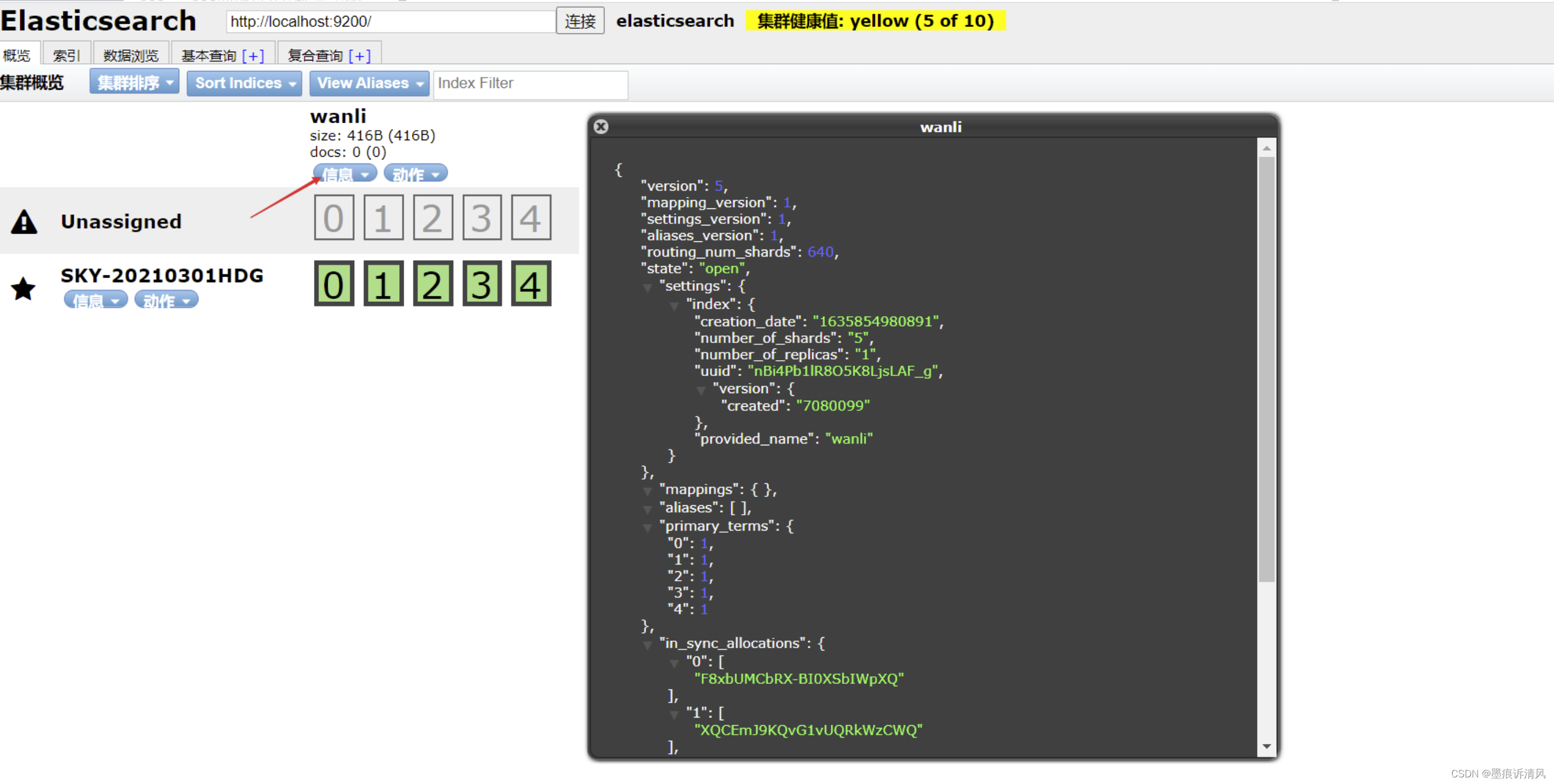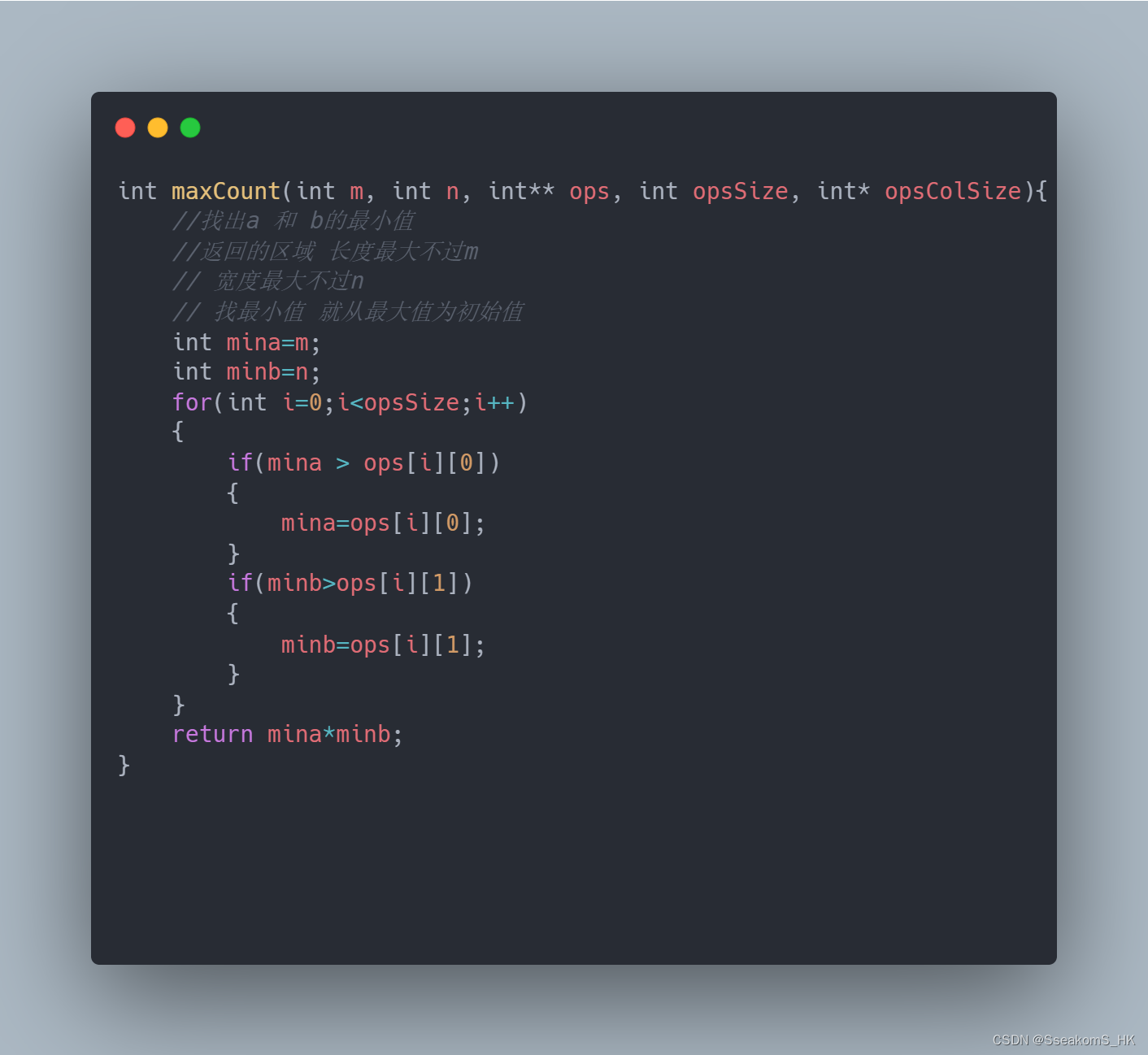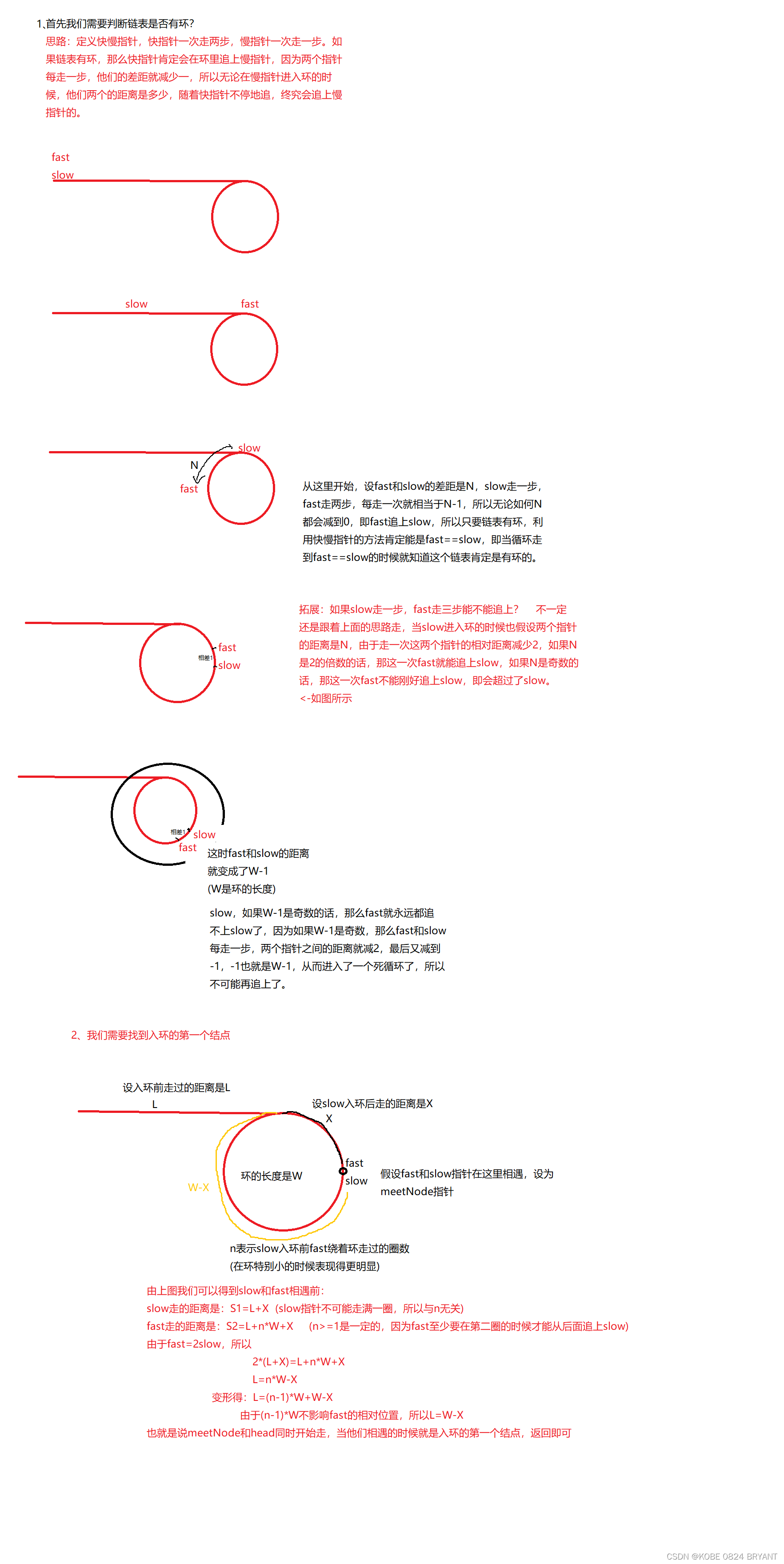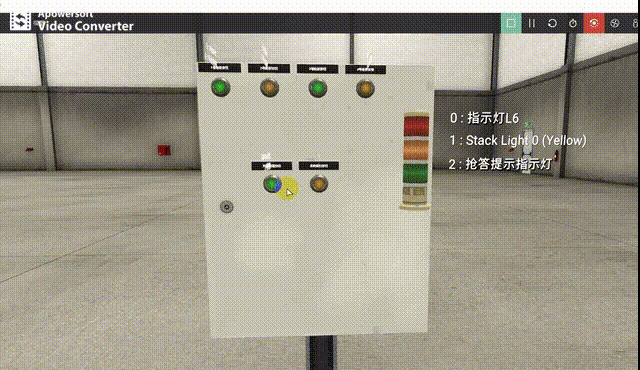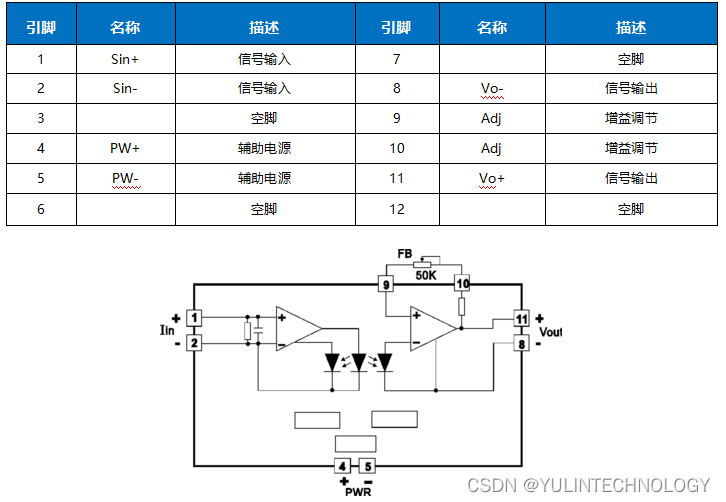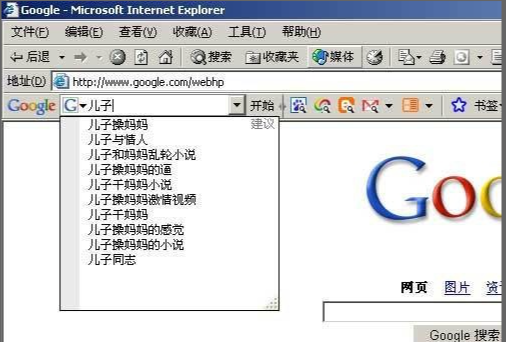第一章 nacos简介
1 2 3 4 5 6 7 8 | Nacos主要帮助我们发现、注册、配置和管理微服务 1. 注册中心功能(Dubbo或者SpringCloud介绍) 2. 配置中心功能 3. 服务管理功能(Dubbo或者SpringCloud介绍) 官网地址: https://nacos.io/zh-cn/index.html |
第二章 nacos环境
1 2 3 4 5 | 1. nacos 依赖 Java 环境来运行 2. 如果源码构建nacos需要安装maven 3. 64 bit OS (windows/Linux/Unix/Mac) 推荐选用 Linux/Unix/Mac 4. 64 bit JDK 1.8+ 5. Maven 3.2.x+ |
第三章 nacos下载和安装
第1节 nacos下载
1 2 3 4 5 6 7 8 9 | 1. 源码下载 git clone https://gitee.com/mirrors/Nacos.git cd Nacos/ mvn -Prelease-nacos -Dmaven.test.skip=true clean install -U ls -al distribution/target/ 编译完成之后生成 nacos-server-2.0.3.tar.gz 和 nacos-server-2.0.3.zip安装包 2. 编译之后版本下载(网络慢可以去国内镜像源码编译) https://github.com/alibaba/nacos/releases |
第2节 nacos安装
1 2 3 4 5 6 7 8 9 10 11 12 13 14 15 16 17 18 19 20 21 | 测试安装采用单点安装 编译好之后再/Nacos/distribution/target/nacos-server-2.0.3/nacos/bin路径下使用命令操作 cd /Nacos/distribution/target/nacos-server-2.0.3/nacos/bin 1. Linux/Unix/Mac/ubuntu系统 1.1 Linux/Unix/Mac 启动命令: sh startup.sh -m standalone 停止命令: sh shutdown.sh 1.2 ubuntu 命令: bash startup.sh -m standalone 2. Windows系统 启动命令: startup.cmd -m standalone 停止命令: shutdown.cmd windows杀死进程的方式 1. 查询进程(通过端口号) netstat -ano | findstr 8080 最后一列为进程号 2. 杀死进程(通过进程号) taskkill /F /PID 11380 |
第3节 nacos控制台访问
1 2 3 | 从日志中可以查看访问控制台的地址,如果是windows访问地址直接在控制台显示,如果是Linux等其他需要自己去日志目录查看日志. 访问密码默认为: nacos/nacos |
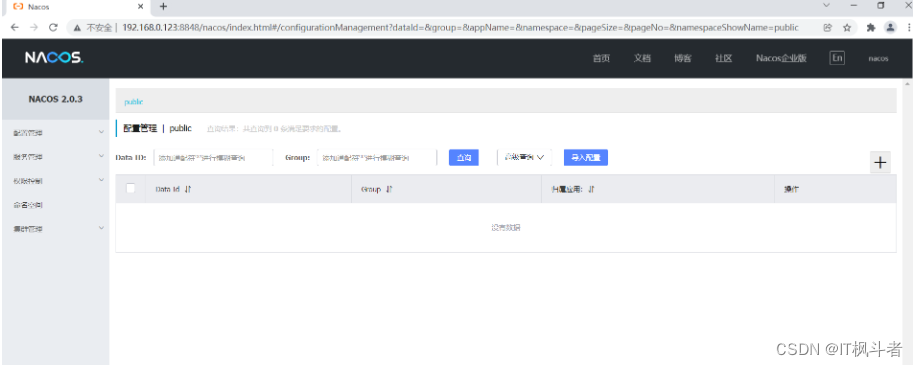
第四章 nacos配置管理(操作台)
第1节 名称空间(命名空间)管理
- 命名空间介绍
1 | 命名空间可以帮助用户更好的管理测试、预发、生产等多环境服务和配置,让每个环境的同一个配置(如数据库数据源)定义不同的值 |
- 命名空间创建和修改
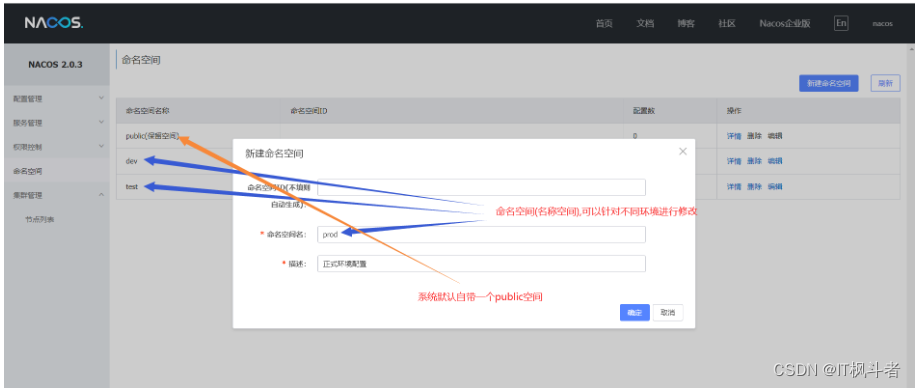
第2节 配置管理
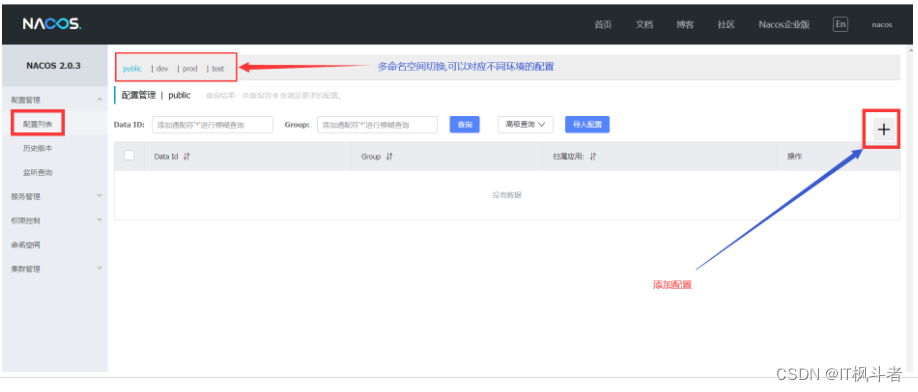
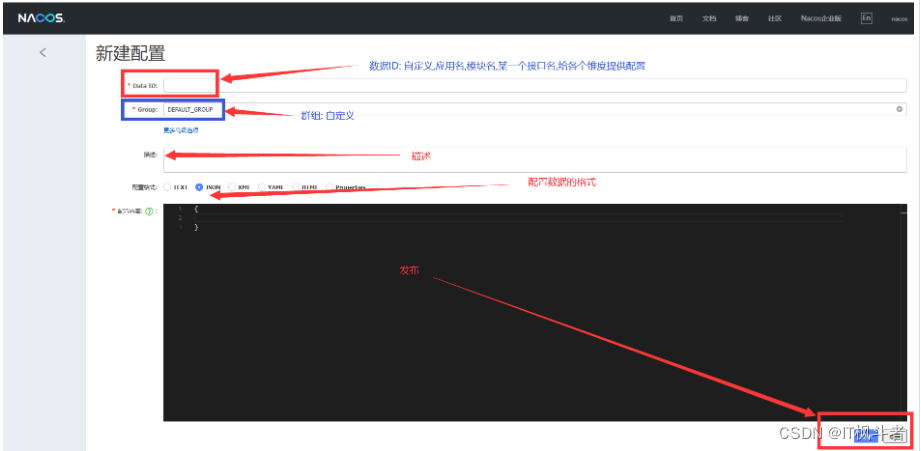
| 参数名 | 参数类型 | 描述 |
|---|---|---|
| dataId | string | 配置 ID,采用类似 package.class(如com.taobao.tc.refund.log.level)的命名规则保证全局唯一性,class 部分建议是配置的业务含义。全部字符小写。只允许英文字符和 4 种特殊字符("."、":"、"-"、"_"),不超过 256 字节 |
| group | string | 配置分组,建议填写产品名:模块名(Nacos:Test)保证唯一性,只允许英文字符和4种特殊字符("."、":"、"-"、"_"),不超过128字节 |

1 | 如果想了解更详细的配置信息请访问: https://nacos.io/zh-cn/docs/console-guide.html |
第五章 nacos配置管理
第1节 Java的SDK使用
- maven依赖
1 2 3 4 5 6 7 8 9 10 11 12 13 14 15 16 17 18 | <!-- nacos客户端依赖 --> <dependency> <groupId>com.alibaba.nacos</groupId> <artifactId>nacos-client</artifactId> <version>2.0.3</version> </dependency> <!-- 依赖guava --> <dependency> <groupId>com.google.guava</groupId> <artifactId>guava</artifactId> <version>31.0.1-jre</version> </dependency> <!-- 依赖slf4j --> <dependency> <groupId>org.slf4j</groupId> <artifactId>slf4j-log4j12</artifactId> <version>1.7.21</version> </dependency> |
- 数据操作
1 2 3 4 5 6 7 8 9 10 11 12 13 14 15 16 17 18 19 20 21 22 23 24 25 26 27 28 29 30 31 32 33 34 35 36 37 38 39 40 41 42 43 44 45 46 47 48 49 50 51 52 53 54 55 56 57 58 59 60 61 62 63 64 65 66 67 68 69 70 71 72 73 74 75 76 77 78 79 80 81 82 83 84 85 86 87 | /**
* 获取nacos配置
*/
@Test
public void test01() throws NacosException {
Properties properties = new Properties();
/*
设置地址
*/
properties.put(PropertyKeyConst.SERVER_ADDR,"127.0.0.1:8848");
/*
设置名称空间
命名空间的值是命名空间ID,不能是命名空间的名字
如果不设置命名空间,那么默认读取自带的public空间
*/
properties.put(PropertyKeyConst.NAMESPACE,"26df001f-7eaa-49eb-95fe-8a28f6acdb7e");
/*
获取配置服务实例
*/
ConfigService configService = NacosFactory.createConfigService(properties);
/*
获取配置实例
第一个参数(dataId): 命名空间下的自定义的 dataId 值
第二个参数(group): 命名空间下的自定义的 group 值
第三个参数(timeoutMs): 读取数据的超时时间
*/
String config = configService.getConfig("tmall", "DEFAULT_GROUP", 3000);
System.out.println(config);
}
/*
* 监听数据变化
*/
@Test
public void test02() throws NacosException {
Properties properties = new Properties();
/*
设置地址
*/
properties.put(PropertyKeyConst.SERVER_ADDR,"127.0.0.1:8849");
/*
设置名称空间
命名空间的值是命名空间ID,不能是命名空间的名字
如果不设置命名空间,那么默认读取自带的public空间
*/
properties.put(PropertyKeyConst.NAMESPACE,"26df001f-7eaa-49eb-95fe-8a28f6acdb7e");
/*
获取配置服务实例
*/
ConfigService configService = NacosFactory.createConfigService(properties);
/*
获取配置实例
第一个参数(dataId): 命名空间下的自定义的 dataId 值
第二个参数(group): 命名空间下的自定义的 group 值
第三个参数(timeoutMs): 读取数据的超时时间
*/
String config = configService.getConfig("tmall", "DEFAULT_GROUP", 3000);
System.out.println(config);
//给当前配置(configService)添加监听器
configService.addListener("tmall", "DEFAULT_GROUP", new Listener() {
public void receiveConfigInfo(String configInfo) {
System.out.println("我是监听器我被触发了...配置信息为:"+configInfo);
}
public Executor getExecutor() {
return null;
}
});
/*
* 防止程序执行完退出,保持进程不退出.
* 在正式项目中项目进程不需要这段代码守护,可以删除
*/
while (true) {
try {
Thread.sleep(1000);
SimpleDateFormat sdf = new SimpleDateFormat("yyyy-MM-dd HH:mm:ss.SSS");
System.out.println("监听中...当前时间: "+sdf.format(new Date(System.currentTimeMillis())));
} catch (InterruptedException e) {
e.printStackTrace();
}
}
}
请多案例请去官网查看: https://nacos.io/zh-cn/docs/sdk.html
|
第2节 Nacos在Spring中的使用(传统ssm)
- 依赖
1 2 3 4 5 6 7 8 9 10 11 12 13 14 15 16 17 18 19 20 21 | <dependency> <groupId>com.alibaba.nacos</groupId> <artifactId>nacos-spring-context</artifactId> <version>1.1.1</version> </dependency> <dependency> <groupId>javax.servlet</groupId> <artifactId>javax.servlet-api</artifactId> <version>3.0.1</version> <scope>provided</scope> </dependency> <dependency> <groupId>org.springframework</groupId> <artifactId>spring-webmvc</artifactId> <version>3.2.18.RELEASE</version> </dependency> 注意: 1. nacos-spring-context使用1.1.1版本的依赖时内嵌spring框架版本为3.2.18.RELEASE 2. nacos和spring框架整合spring版本不是重点,所以springmvc依然使用3.2.18.RELEASE版本做测试 3. 官网采用web的方式进行测试,所以案例中引入了springmvc |
-
案例步骤
-
- 第1步: 创建JavaWeb项目,添加依赖(上面)
-
- 第2步: 配置springmvc
1 2 3 4 5 6 7 8 9 10 11 12 13 14 15 16 17 18 19 20 21 22 23 24 25 26 27 28 | 2.1 web.xml中配置 <?xml version="1.0" encoding="UTF-8"?> <web-app xmlns:xsi="http://www.w3.org/2001/XMLSchema-instance" xmlns="http://java.sun.com/xml/ns/javaee" xsi:schemaLocation="http://java.sun.com/xml/ns/javaee http://java.sun.com/xml/ns/javaee/web-app_3_0.xsd" metadata-complete="true" version="3.0"> <!--配置springmvc的核心控制器--> <servlet> <servlet-name>dispatcherServlet</servlet-name> <servlet-class>org.springframework.web.servlet.DispatcherServlet</servlet-class> <load-on-startup>1</load-on-startup> </servlet> <servlet-mapping> <servlet-name>dispatcherServlet</servlet-name> <url-pattern>/</url-pattern> </servlet-mapping> </web-app> 2.2 配置springmvc核心配置文件(dispatcherServlet-servlet.xml) <?xml version="1.0" encoding="UTF-8"?> <beans xmlns="http://www.springframework.org/schema/beans" xmlns:xsi="http://www.w3.org/2001/XMLSchema-instance" xmlns:context="http://www.springframework.org/schema/context" xsi:schemaLocation="http://www.springframework.org/schema/beans http://www.springframework.org/schema/beans/spring-beans.xsd http://www.springframework.org/schema/context http://www.springframework.org/schema/context/spring-context.xsd"> <!--配置扫描包 --> <context:component-scan base-package="io.ukoko"></context:component-scan> </beans> |
-
- 第3步: 配置nacos(采用Java类配置方式)
1 2 3 4 5 6 7 8 9 10 11 12 13 14 15 16 17 18 19 20 21 22 23 24 25 26 27 28 29 30 31 32 33 34 35 36 37 38 39 | import com.alibaba.nacos.api.annotation.NacosProperties;
import com.alibaba.nacos.spring.context.annotation.config.EnableNacosConfig;
import com.alibaba.nacos.spring.context.annotation.config.NacosPropertySource;
import org.springframework.context.annotation.Configuration;
@Configuration //设置当前类为配置类
@EnableNacosConfig(globalProperties = @NacosProperties(serverAddr = "127.0.0.1:8848")) //开启nacos配置,制定其nacos服务器地址
@NacosPropertySource(dataId = "tmail",groupId = "DEFAULT_GROUP",autoRefreshed = true) //nacos配置中心基础配置
public class NacosConfiguration {
}
注意: nacos官网使用的是此种配置方式(Java类配置),但是一般在ssm项目中我们常使用xml配置,如果使用xml配置,那么不需要当前配置类,只需要在dispatcherServlet-servlet.xml中添加以下配置即可
<?xml version="1.0" encoding="UTF-8"?>
<beans xmlns="http://www.springframework.org/schema/beans"
xmlns:xsi="http://www.w3.org/2001/XMLSchema-instance"
xmlns:context="http://www.springframework.org/schema/context" xmlns:nacos="http://nacos.io/schema/nacos"
xsi:schemaLocation="http://www.springframework.org/schema/beans http://www.springframework.org/schema/beans/spring-beans.xsd http://www.springframework.org/schema/context http://www.springframework.org/schema/context/spring-context.xsd http://nacos.io/schema/nacos http://nacos.io/schema/nacos.xsd">
<!--配置扫描包 -->
<context:component-scan base-package="io.ukoko"></context:component-scan>
<!--
开启nacos注解驱动
-->
<nacos:annotation-driven></nacos:annotation-driven>
<!--
配置nacos服务器
-->
<nacos:global-properties server-addr="127.0.0.1:8848"></nacos:global-properties>
<!--
nacos服务器数据配置
-->
<nacos:property-source data-id="tmail" group-id="DEFAULT_GROUP" auto-refreshed="true"></nacos:property-source>
</beans>
|
| 配置文件的样例 |
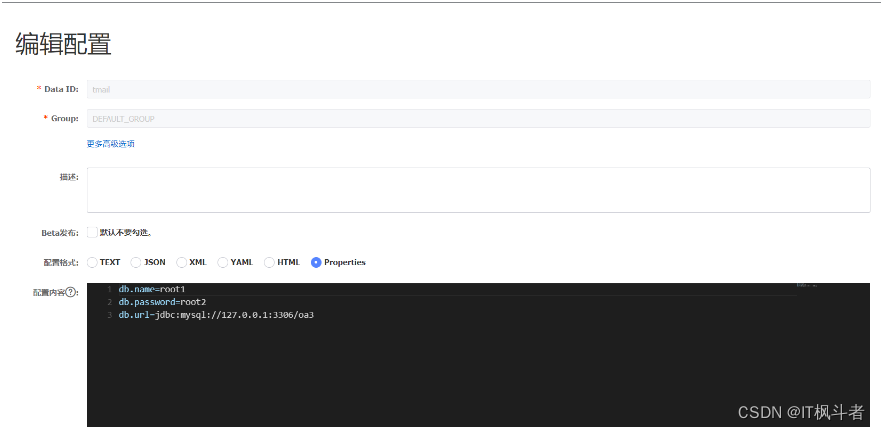 |
-
- 第4步: 编写测试代码
1 2 3 4 5 6 7 8 9 10 11 12 13 14 15 16 17 18 19 20 21 22 | @Controller
public class NacosController {
/*
@NacosValue注解: 获取nacos配置中心配置文件.
${db.name}表达式: nacos配置为properties db.name为自定义的key
autoRefreshed属性: 自动刷新,如果配置文件有改动,会自动刷新
*/
@NacosValue(value = "${db.name}",autoRefreshed = true)
private String userName;
@NacosValue(value = "${db.password}",autoRefreshed = true)
private String password;
@NacosValue(value = "${db.url}",autoRefreshed = true)
private String url;
@ResponseBody
@RequestMapping(value = "/test02",method = RequestMethod.GET)
public String test02(){
return userName+"="+password+"="+url;
}
}
|
第3节 SpringBoot使用
- 依赖
1 2 3 4 5 6 7 8 9 10 11 12 13 14 15 | <!-- spring web依赖 --> <dependency> <groupId>org.springframework.boot</groupId> <artifactId>spring-boot-starter-web</artifactId> </dependency> <!-- nacos-springboot依赖 --> <dependency> <groupId>com.alibaba.boot</groupId> <artifactId>nacos-config-spring-boot-starter</artifactId> <!-- 注意:0.2.x版本nacos对应springboot2.x版本,但是不能高于2.4.x版本,我这里使用springboot的2.3.9.RELEASE版本 --> <version>0.2.10</version> </dependency> /* 注意: 如果项目中使用的SpringBoot的版本过高没有相对应的nacos依赖那么请使用传统API通过自定义配置方式进行功能实现 */ |
- 案例
1 2 3 4 5 6 7 8 9 10 11 12 13 14 15 16 17 18 19 20 21 22 23 24 25 26 27 28 29 30 31 32 33 34 35 36 37 38 | 1. 配置文件 application.properties
# 配置文件中只需要指定nacos服务器地址即可
nacos.config.server-addr=127.0.0.1:8848
2. Java代码
@Controller
@SpringBootApplication
/*配置名称空间*/
@EnableNacosConfig(globalProperties = @NacosProperties(namespace = "a79dd942-05e1-49d8-b85c-a87f94bf4544"))
/*配置data-id*/
@NacosPropertySource(dataId = "tmail",autoRefreshed = true)
public class NacosSpringbootApplication {
public static void main(String[] args) {
SpringApplication.run(NacosSpringbootApplication.class, args);
}
/**
* 指向nacos配置中心的属性
* ${db.user}: 表达式获取配置中心配置db.user自定义的key
* autoRefreshed: 是否开启自动刷新,不开启修改配置,此属性不生效
*/
@NacosValue(value = "${db.user}",autoRefreshed = true)
public String userName;
/**
* 获取配置文件的测试方式
*/
@ResponseBody
@RequestMapping(value = "/test",method = RequestMethod.GET)
public String test(){
return userName;
}
}
|
第六章 nacos的高可用
1 2 3 4 5 6 7 8 9 10 11 12 13 14 15 16 17 18 19 20 21 | 集群搭建注意事项: 官网介绍了在Linux/Unix下集群安装,集群必须节点至少3个以上,其他请查看官网 https://nacos.io/zh-cn/docs/cluster-mode-quick-start.html 搭建步骤: (本文在虚拟机里模拟,Linux操作系统为Centos) 第1步: 在/home/hs文件夹创建nacos-cluster文件夹 mkdir nacos-cluster 第2步: 在nacos-cluster文件夹文件夹下创建3个文件夹 mkdir nacos1 nacos2 nacos3 第3步: 上传文件nacos-server-2.0.4.tar.gz(开篇编译nacos源码生成[不要在windows下编译源码])分别到nacos1、nacos2、nacos3文件夹中 第4步: 将nacos1、nacos2、nacos3文件夹中的nacos-server-2.0.4.tar.gz解压 tar -zxvf nacos-server-2.0.4.tar.gz 第5步: 配置文件修改 5.1 解压完成之后生成一个nacos文件夹,由于3个节点都在同一台服务器上,所以需要修改每一个节点的默认端口号(原端口号为8848) 5.2 分别修改nacos1、nacos2、nacos3中的nacos默认端口号,默认端口号修改位置 /home/hs/nacos-cluster/nacos*/nacos/conf/application.properties,端口号修改为7777 8888 9999 5.3 修改集群配置 5.3.1 分别将/home/hs/nacos-cluster/nacos1/nacos/conf/cluster.conf.example 这个配置文件名字修改为 cluster.conf 5.3.2 分别配置三个节点中的cluster.conf文件,在三个配置文件中添加以下配置(ip:port),ip地址不要用本机回环地址 192.168.80.128:7777 192.168.80.128:8888 192.168.80.128:9999 第6步: 启动集群(nacos依赖JAVA_HOME,如果虚拟机内存过小会造成启动失败,至少大于4G) 6.1 启动命令: 我这里使用内置数据源 命令为: sh startup.sh -p embedded 6.2 成功标志: 在所有服务器日志中打印 Nacos started successfully in cluster mode. use embedded storage 6.3 测试: 任意登录一个图形界面,设置配置,会被同步到其他服务器节点 |
| 集群启动成功 |
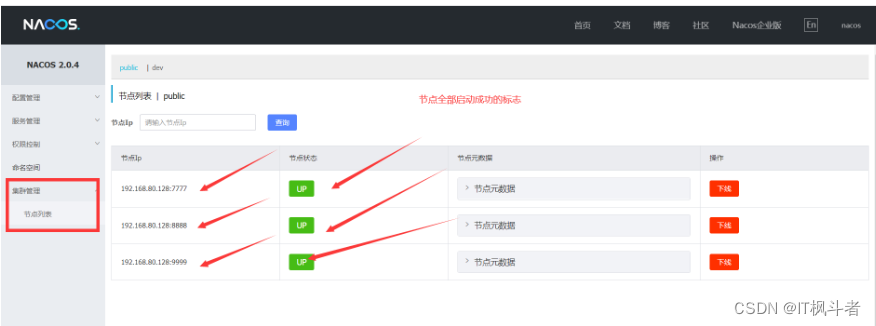 |
第七章 nacos集群操作
第1节 Java SDK版本
1 2 3 4 5 6 7 8 9 10 11 12 13 14 15 16 17 18 19 20 21 22 23 24 25 26 27 28 | /**
* 配置中心: 集群操作
* 第五章#第1节 案例类似
*/
@Test
public void test01() throws NacosException {
Properties properties = new Properties();
/*
设置地址
如果为集群,需要用逗号分割即可
集群如果有3个点,如果集群down掉2个那么集群不会在提供服务,如果只down掉1个,那么集群正常提供服务
*/
properties.put(PropertyKeyConst.SERVER_ADDR,"192.168.80.128:7777,192.168.80.128:8888,192.168.80.128:9999");
/*
获取配置服务实例
*/
ConfigService configService = NacosFactory.createConfigService(properties);
/*
获取配置实例
第一个参数(dataId): 命名空间下的自定义的 dataId 值
第二个参数(group): 命名空间下的自定义的 group 值
第三个参数(timeoutMs): 读取数据的超时时间
*/
String config = configService.getConfig("tmail", "DEFAULT_GROUP", 3000);
System.out.println(config);
}
|
第2节 SpringBoot版本
1 2 3 4 5 6 | 使用第五章#第3节案例 只需要在applicaton.properties中将nacos服务器地址修改为 nacos.config.server-addr=192.168.80.128:7777,192.168.80.128:8888.192.168.80.128:9999 注意事项: 1. 集群正常提供服务的策略和第七章第1节介绍的相同 2. 不同的地方是当集群中有节点down掉之后修改配置中心的配置,在springboot应用中获取不到最新的配置 3. 集群如果没有节点down掉,在修改配置中心文件的时候,不影响本地获取最新修改的配置信息 |
第八章 nacos一致性协议
第1节 CAP定理简介
1 2 3 | CAP定理,又被称作布鲁尔定理,指在一个分布式系统中的一致性(Consistency),可用性(Availability),分区容错性(Partition tolerance)英文缩写. 在分布式系统中系统要么保证CP要么保证AP,不可能同时满足CAP |
第2节 nacos一致性协议介绍
1 | 一致性协议介绍来源于nacos官网顶部菜单栏【NACOS架构与原理】(需要登录阿里云) |
2.1 nacos作为注册中心
1 | nacos作为注册中心:保证的是AP |
2.2 nacos作为配置中心
1 | nacos作为配置中心:保证的是CP |




